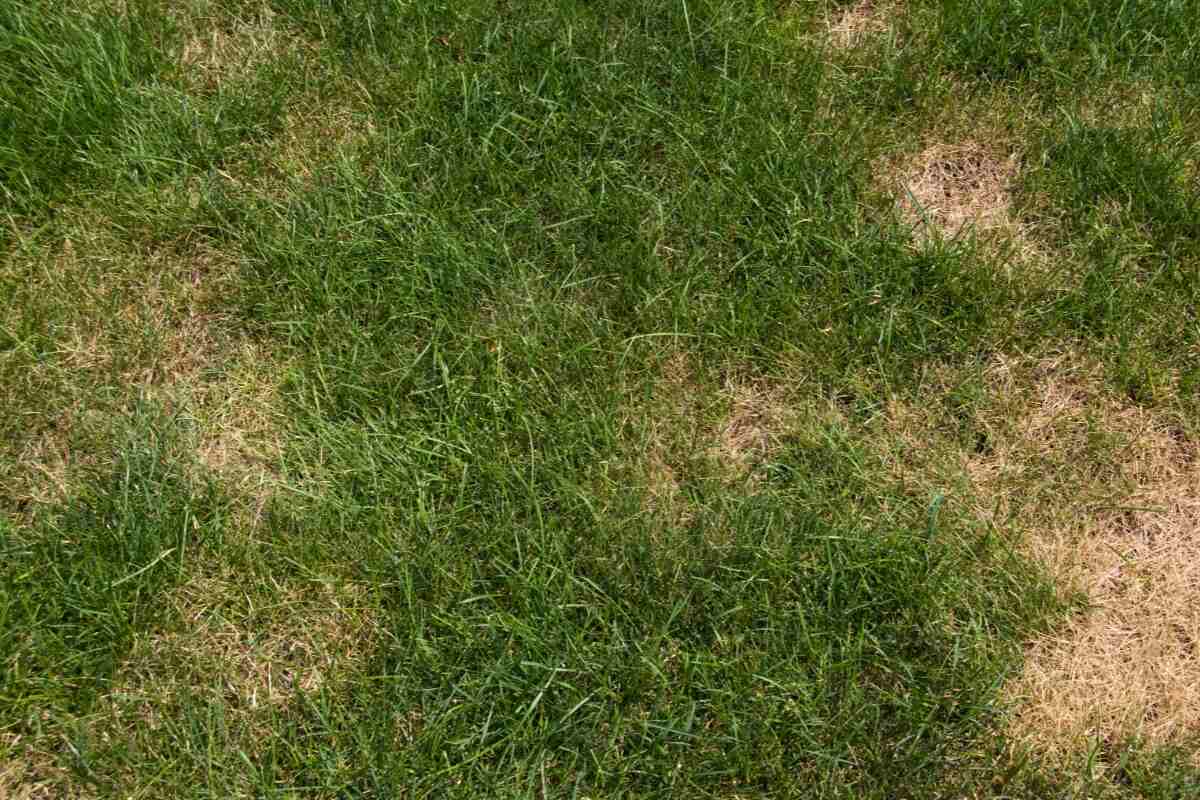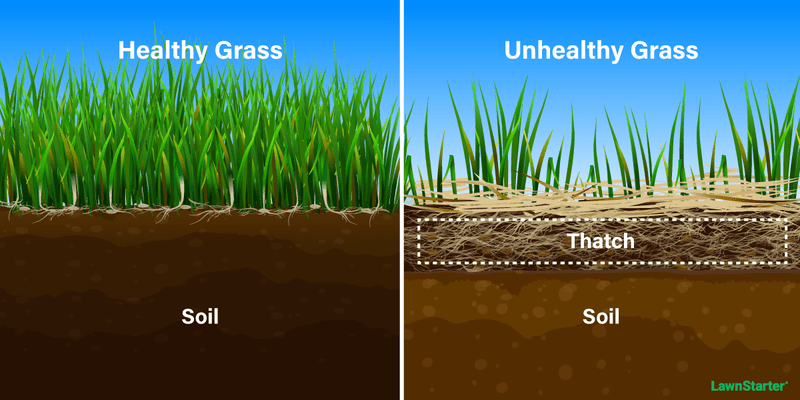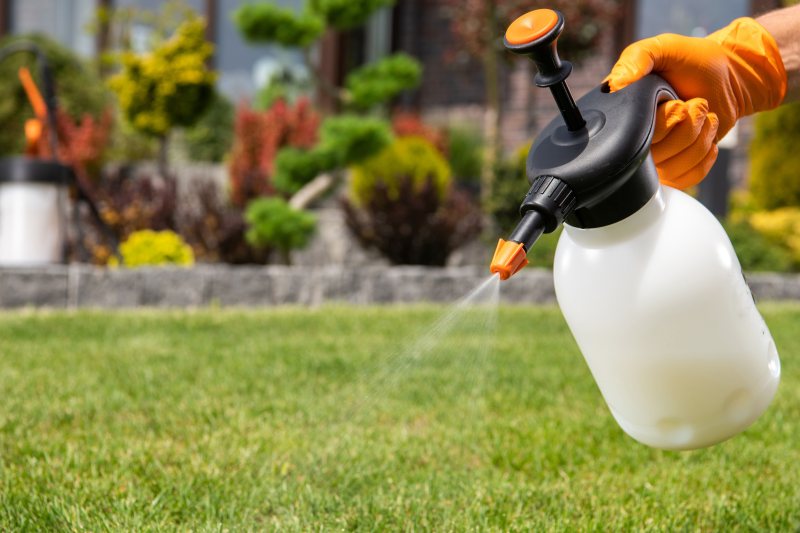
Lawn fungal treatments cost, on average, $5 to $8 per 1,000 square feet for one application if you DIY. The price increases if you go for a professional job, but expertise is essential in severe infestations. Several types of fungus treatments work in tandem with preventative applications and routine lawn maintenance. Read on to discover how they work and how you can prevent lawn fungus.
What is Lawn Fungus

Lawn fungus can turn a green lawn into a mass of wilted, brown spots overnight. Tiny organisms called fungi enter the grass tissue and use it to grow and multiply, damaging or even killing the plant.
Fungi dwell in the thatch layer, fallen leaves, and other organic matter. They are spread by spores and hyphae in humid, warm weather, attacking turfgrass. Several factors make a lawn more susceptible to fungal infection, including:
- Dormancy: Cool-season grasses like Kentucky bluegrass and fescues are susceptible in the summer when entering dormancy. Warm-season turfs like Bermudagrass and Zoysia are more at risk during the fall and early spring when entering and exiting their dormancy periods.
- Stress: Drought stress, high temperatures, scalping, under-fertilization, and overwatering stress and weaken your turfgrass.
- Soil compaction: Compacted soil leads to shallow roots, stressing your lawn.
- Pests and disease: While smothered by weeds or damaged by lawn pests, your lawn can not recover as quickly from fungal disease.
How to Identify Lawn Fungus
How do you know nasty fungi might be active in your lawn? Infected grass shows these fungal disease symptoms:
- Straw-like or brown spots (but also orange, pink, or other colors) on grass leaves.
- Withered, bleached, or yellow leaves.
- Brown or black rot on leaf sheaths, crowns, and roots.
- Dark or whitish, cottony growth on plants and soil.
- Small, rigid pea-like structures (sclerotia) on grass leaves.
- Irregular or circular patches with grass discoloration, taller and greener grass, or mushrooms.
- Patches of wilted, dead grass.
Types of Fungicides

You can choose between contact and systemic fungicides. Consider natural or biological formulas if you want an eco-friendly option. Prices and effectiveness vary with the type of fungicide. Let’s see what each type has to offer:
Contact Fungicides
Contact fungicides are not absorbed into plant tissue. They adhere to the surface and form a protective layer that keeps fungi from entering the plant. Unfortunately, this barrier doesn’t extend to new growth, and contact fungicides must be reapplied every seven to 14 days.
Additionally, water breaks down the protective shield, requiring repeat treatments after rain or irrigation sessions. To sum it up, contact fungicides are less durable, and repeated applications increase the total cost.
Contact fungal products work best when used as a preventative measure or for small infestations in localized areas. They are most suitable as preventive fungicides but not for curative actions.
Active ingredients in contact fungicides include:
- Captan
- Citric acid
- Neem oil
Systemic Fungicides
Systemic fungicides, or penetrants, are absorbed into the plant tissue. These curative fungicides can hunt the fungi inside the plant and stop the infection in its early stages.
However, there’s a limit to their fungi-killing powers. They are most effective when applied within the first 24 to 72 hours after infection. Once fungi colonize heavily on the grass plant, there’s not much they can do. The earlier you use them on your lawn, the more grass you can save.
A single application can last up to four weeks, making systemic fungicides easier to use and less costly than contact products. In severe cases, the application frequency and sometimes the application rate increase.
Systemic fungicides work as curative and preventative fungicides, making them one of the best all-around fungicides. Some examples of systemic fungicides commonly used for treating home lawns are:
- Azoxystrobin
- Propiconazole
- Pyraclostrobin
- Myclobutanil
- Thiophanate-methyl
Natural Fungicides
Natural fungicides work slower than chemical options, but they are safer to use and less damaging to the environment. Neem oil, clove oil, and lemon juice (citric acid) are effective natural fungicides used in both DIY solutions and commercial products.
According to the University of New Hampshire, neem oil prevents spore germination and penetration of the leaf tissue, and studies show it has good results against powdery mildew and brown patch disease.
Pro tip: Mix one ounce of neem oil with one gallon of water to prepare a DIY neem fungicide. Apply 2.5 gallons of solution per 1,000 square feet. Neem oil costs between $1 to $1.50 per ounce or $2.50 to $3.75 to treat 1,000 square feet.
Biological Fungicides
Also known as biofungicides, these products use beneficial microorganisms to protect the grass from pathogenic fungi. Bacillus amyloliquefaciens, Bacillus subtilis, and Trichoderma species are most commonly used.
Trichoderma harzianum, for example, acts on multiple fronts. It colonizes the roots and forms a protective barrier, consumes the excess nutrients in the soil, and releases chitinases, an enzyme that denatures the cell walls of fungal pathogens.
Biological fungicides are less popular but easy to use, affordable, and more durable than other options. They are also eco-friendly, and fungi can’t develop resistance. Some well-known brands include:
Broad-Spectrum vs. Narrow-Spectrum Fungicides
Broad-spectrum fungicides control multiple unrelated groups of fungi. They give you a better chance of targeting the fungi in your lawn, even if you’re not 100 percent sure which one is infesting your grass. For example, azoxystrobin is one of the most effective active ingredients in broad-spectrum fungicides. It controls:
- Anthracnose
- Brown patch
- Leaf spot
- Fairy rings
- Necrotic ring spot
- Pythium blight
- Spring dead spot
- Take-all patch
Narrow-spectrum fungicides only control related fungi. To see results, you need to know what pathogen is infesting your turf. Narrow-spectrum products don’t harm beneficial fungi, like Arbuscular mycorrhizal, that help your grass grow.
Delivery Methods
You can apply fungicides on your lawn in either liquid or granular form.
Liquid fungicides require a sprayer. You can use a hose-end sprayer connected to a garden hose or go for a backpack pump sprayer suitable for larger lawns. Liquid formulas typically work faster because they are more easily absorbed into foliage and soil. They cost about $5.25 per 1,000 square feet.
Granular fungicides are applied with a lawn spreader. They usually take longer to work because they need time to dissolve. Granular products cost, on average, $7.75 per 1,000 square feet.
How to Apply Fungal Treatments
Some homeowners leave fungal treatments to the pros, but DIY applications are simple if you follow four simple steps:
1. Make Sure You Need a Fungicide
Remember, some fungal disease symptoms are similar to damaged turfgrass from other causes, such as:
- Under or overwatering
- Improper fertilizing or mowing
- Grass damage from herbicides, pesticides, pet urine, and other chemicals
- Poor drainage due to soil compaction or excessive thatch
- Weeds or pest damage
- Extreme temperatures
First, take a tour of your yard, check the soil, consider the weather, and recheck your lawn care routine. Then, enter the fungal disease identification business.
2. Choose the Right Fungicide
When you choose an antifungal, ensure it’s meant for the pathogen wreaking havoc on your turf. Not all fungal diseases require chemical control. Some, like yellow patch, rust, and Ascochyta blight can be dealt with through cultural practices like lawn maintenance.
Reference the chart below to help identify your lawn fungus:
| Lawn fungal disease | Main signs and symptoms |
| Dollar spot | Small, circular, dollar-sized yellow, straw-colored, or light brown spots extending up to five inches wide |
| Red thread | Reddish or pinkish patches up to two feet wide |
| Brown patch | Small, irregular brown patches with sunken centers up to a few feet wide |
| Large patch | Small, irregular areas up to 12 inches wide with tan-orange grass |
| Yellow patch | Circular yellow to light-brown patches five inches to a few feet wide |
| Pythium blight | Small circles of withering, blackened, or reddish-brown grass two to six inches wide following water patterns |
| Fairy rings | Circular or semi-circular bands of taller, greener grass, dry, straw-colored to light brown turf, or mushrooms |
| Gray leaf spot | Irregular blighted patches with bleached, twisted leaves and small, water-soaked lesions, sometimes covered in grayish spores |
| Powdery mildew | Light green whitish areas that look like chalk powder |
| Spring dead spot | Circular spots of bleached-out, dead grass, six to 12 inches wide; can merge into larger patches |
| Summer patch | Yellow to tan circular areas of dead grass up to one foot wide |
| Rust | Shifts from golden yellow to orange rust; irregular patches with orange powder |
| Leaf spot | Irregular areas of off-color turf; grass stems, sheaths, and blades possess elongated or circular light brown spots |
| Melting out | Patches of yellow to blackish-brown wilted or dead grass; dark brown rot on roots and crowns |
| Take-all Root Rot | Chlorotic, yellow to light green patches that eventually turn brown, thin out, and become bare areas |
| Leaf blight | Irregular patches with blighted, straw-colored, or brown grass; appear overnight |
| Gray snow mold | Whitish, straw-like, crusted circular or irregular patches with gray fungal mycelium; found near receding snow banks |
| Pink snow mold | Pink, white, or tan circular patches one to 12 inches wide; appear when snow melts in the spring |
| Anthracnose | Bright yellow, reddish, or bronze patches of various sizes; dark brown to black lesions on basal roots |
These diseases commonly affect the following turfgrasses:
| Lawn fungal disease | Susceptible grasses |
| Dollar spot | Fine fescue, perennial ryegrass, bentgrass, centipedegrass, Kentucky bluegrass, tall fescue, Bermudagrass, and Zoysiagrass |
| Red thread | Fine fescue, perennial ryegrass, bentgrass, and Kentucky bluegrass |
| Brown patch | Ryegrass, tall fescue, creeping bentgrass, Kentucky bluegrass, and fine fescue |
| Large patch | Zoysiagrass, Centipedegrass, St. Augustine, and Bermudagrass |
| Yellow patch | Creeping bentgrass, Kentucky bluegrass, perennial ryegrass, Bermudagrass, and Zoysiagrass |
| Pythium blight | Perennial ryegrass, creeping bentgrass, fine fescues, and bluegrasses |
| Fairy rings | All lawn grasses |
| Gray leaf spot | St. Augustinegrass, perennial ryegrass, centipedegrass, tall fescue, and Bermudagrass |
| Powdery mildew | Kentucky bluegrass and fescues |
| Spring dead spot | Bermudagrass, seashore paspalum, and Zoysiagrass |
| Summer patch | Kentucky bluegrass, fescues, bentgrass, and annual bluegrass |
| Rust | Kentucky bluegrass and perennial ryegrass |
| Leaf spot | Kentucky bluegrass, perennial ryegrass, and tall fescue |
| Melting out | Kentucky bluegrass, perennial ryegrass, and tall fescue |
| Take-all Root Rot | All warm-season turfgrasses |
| Leaf blight | Annual bluegrass, creeping bentgrass, perennial ryegrass, tall fescue, Kentucky bluegrass, and fine fescue |
| Gray snow mold | All cool-season turfgrasses |
| Pink snow mold | All cool-season turfgrasses |
| Anthracnose | Annual bluegrass, creeping bentgrass, Kentucky bluegrass, fine fescues, perennial ryegrass, and Bermudagrass |
Pro tip: Send a grass sample for testing at a plant pathology lab near you. You can also consult a lawn care professional or your local Cooperative Extension Office expert.
3. Take Safety Precautions
When applying chemicals to your lawn, even natural fungicides, wear safety equipment and ensure pets and kids don’t have access to the lawn until the solution dries. Common safety equipment include:
- Safety glasses or goggles
- Mask
- Gloves
- Long sleeves
- Close-toed shoes
4. Apply Fungicide
There are five factors required for successful fungicide applications:
- Volume: Generally, applications require two to four gallons of fungicide solution per 1,000 square feet.
- Spray nozzle type: Mississippi State’s University Extension recommends hollow-cone nozzles that produce medium-fine droplets for even coverage.
- Spray pressure: 40 to 60 pounds per square inch offers the best coverage and canopy penetration.
- Timing: For the best results, apply preventive treatments before infestation, typically after heavy rain and during high humidity seasons.
- Repetition: Reapply fungicide every seven to 14 days until the infestation is eradicated.
Always follow the manufacturer’s instructions regarding the application rate. Successful fungal treatments are only one part of your overall pest management strategy.
Lawn Care Practices for Fungus Control
While your grass is infected, adjust your lawn care tactics to contain the disease by following a few simple rules:
- Always work (mow, aerate, fertilize, etc.) healthy areas first to prevent fungal spores from spreading.
- Clean lawn care equipment after each use and sharpen mower blades annually.
- Remove grass clippings from your lawn.
- Mow your lawn taller.
- Never trim your grass when it’s wet.
- Aerate and dethatch your lawn annually.
- Don’t water in the evening.
- Water deeply and less often to reduce excessive moisture.
- Remove the morning dew if possible.
- Trim trees and shrubs to improve air circulation and sun exposure.
- Practice regular pest and grub control.
Lawn Recovery After Fungal Disease
Most homeowners hope for a fast recovery, but this is rarely true. Be patient and prepare for up to two months of a messy, recovering lawn. In the meantime:
- Continue mowing: Mowing regularly gradually removes the damaged blades of grass.
- Apply grass paint. If you’re dealing with off-color patches and you need a beautiful lawn fast, consider applying grass paint.
- Install sod: If the lawn disease leaves behind bare patches, remove the dead grass from the affected area and install new sod.
- Overseed: Overseed your lawn with resilient grass seed to prevent weeds from taking over and repair thinning turf.
FAQ About Lawn Fungus Treatments
Can You Use Vinegar and Baking Soda as a Lawn Fungicide?
Yes, you can use vinegar and baking soda as a lawn fungicide. However, you should be careful. While vinegar can help treat some fungal diseases, it can also harm your grass. As for baking soda, according to Purdue University, it is effective against plant diseases when used with oil. However, the sodium in baking soda can build up and harm your landscape plants.
Will Lawn Fungus Go Away on Its Own?
No, lawn fungus won’t go away on its own. Most common lawn diseases are seasonal and enter dormancy when environmental conditions are no longer suitable for growth. But when left untreated, the disease returns the next season with larger patches, causing more severe damage.
What is the Best Time of Year to treat Lawn Fungus?
The best time of year to treat lawn fungus depends on your type of grass and location. Focus on your humid, rainy seasons, whether that covers the spring and fall or the summer. Use past weather patterns and your local climate to determine your best window for preventive applications.
Find a Pro For Lawn Fungus Treatments
It’s best to call the pros when you discover signs of fungal infection in your grass. It gives you the best chance to save your turf with minimum expenses. Let LawnStarter connect you with the best lawn treatment experts in your area. Get the best lawn fungus treatment and keep your lawn in shape year-round.
LawnStarter participates in the Amazon Services LLC Associates Program, an affiliate advertising program. LawnStarter may earn revenue from products promoted in this article.
Main Photo Credit: nycshooter / Canva Pro / License